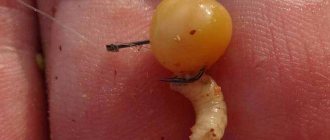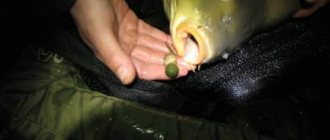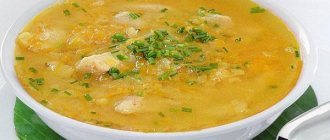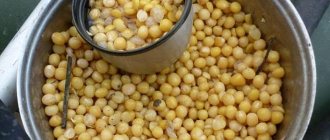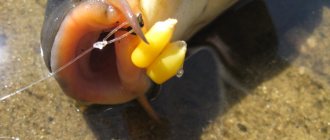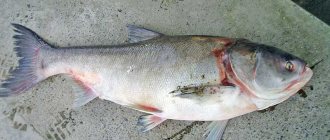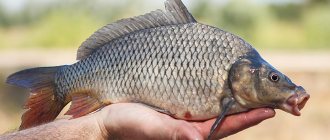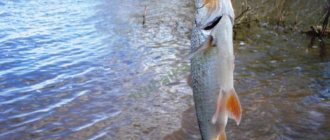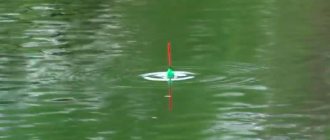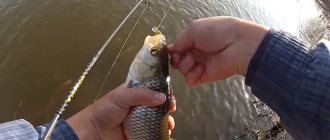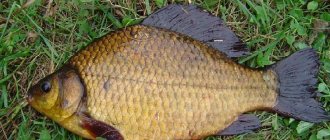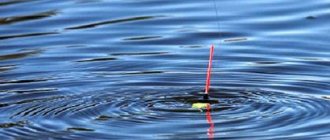Despite the fact that the life cycle of ide is year-round, good bites of this fish cannot be observed in all seasons. The most favorable time for fishing ide is the period after spawning. Catching ide with peas shows excellent results in the warm season. In this article we will talk about how to properly prepare catchable pea bait.
Yaze tackle
Pea bait is most optimally combined with fishing from a boat. Of course, you can fish from the shore, but most fishermen prefer from a boat, since catching ide with peas this way is more interesting and gives you a better chance of returning with a rich catch.
As onboard equipment you will need any classic float rod 1.2 - 1.5 m long with a wire reel and nod, 15 - 20 meters of main line with a diameter of 0.4 mm, 20 - 30 cm of monofilament with a thickness of 0.2 - 0.3 mm for a leash, a sliding sinker and a fixing cambric. Hooks should be thin and light - No. 6-10, with a short shank and a sting curved inward. The peas must be placed on the hook in such a way that they almost completely cover the shank area.
How to prepare gear for catching ide from a boat.
Experienced fishermen recommend using ordinary hog fishing rods 1.2-1.5 meters long, on which a wire reel is installed and a medium-hard nod is required. You should not use longer gear when fishing from a boat, as this may somewhat complicate the processes of casting bait or landing fish if fishing is carried out under trees.
Rods of shorter length are also not a very profitable solution. This is due to the fact that with a fishing rod that is too short, it is not always possible to quickly remove the formed arc of the fishing line (its slack) that appears after casting, and this is an important point, since hooking should be done in a matter of seconds after the fish bites.
Conventional telescopic options with a test load of up to 40 grams are perfect as a fishing rod. When preparing the tackle, special attention must be paid to the quality of the installation of the pussy, which you can make yourself using a spring from a soldier’s cap or purchase a ready-made version at a fishing store.
The nod should be firmly attached to the tip of the rod; its length can be adjusted during the fishing process based on the weight of the equipment used, as well as the activity of the fish. Note that the presence of such a bite alarm guarantees the highest possible sensitivity of the gear, so that even the weakest bite will not go unnoticed.
A fishing line with a cross-section of 0.25 mm (main) is wound on the reel, the leash is made of fishing line, the diameter of which can be in the range of 0.14-0.2 mm (the choice depends on the size of the intended trophy), the length of the leash is 30-50 cm.
The load is installed sliding, you can also use a blind version of the equipment, but in this case it is divided into several parts (3-5) and installed at a distance of 25 cm from the hook and then every 15 cm.
As for hooks, the best options are considered to be options No. 4-5 with a short shank; the tip must necessarily point inward. Note that the hook should be almost completely hidden in the bait used for fishing.
Ide for peas
Recipe for making pea bait
In order for peas to be used as bait, they must be properly cooked. When buying peas, choose wrinkled and unshelled grains rather than smooth ones - they are faster to cook. First you need to fill the pea grains with water and leave for 6-8 hours to swell. You can add a little salt and sugar to the water. After this time, you need to put a container with water and swollen peas on the fire and cook until the grains become soft.
However, be careful not to overcook the peas, as peas that are too soft will have a worse hold on the hook and will clump in strong currents. How the readiness of the bait is checked can be seen in a specially prepared story - “catching ide with peas - video material”:
Drain the remaining water from the container and rinse the grains under cool water. In this way, you will increase the useful life of the prepared bait without allowing it to sour. Place the finished bait in a hard container for transportation so as not to crush the peas along the way.
Pea nozzle
It should be noted that catching ide with peas is quite convenient. After all, properly cooked peas stick well to the hook. Large fish are caught with it, but small fish pass by. Peas can also serve as an excellent option for feeding ide.
It is best to prepare steamed peas for bait. Which, when properly welded, can serve as the key to successful fishing. To be fair, it must be said that ides do not like bread crumbs and various worms, and they only bite on them in rare cases. But you can only catch roaches with such a bait, and even then in the height of summer.
It is best to prepare a pea bait for ide fishing in the following way: take a suitable container into which the peas are poured so as to cover a third of the bowl’s volume. The whole thing is filled with water and left to swell overnight. If the peas have absorbed all the liquid during this time, you can add it.
The swollen peas must be placed on low heat. Directly with water and cook until the peas acquire the required softness. You can check this by crushing a pea with your fingers - if it works, then the bait is ready and you can take it with you fishing. To increase its useful life , peas can be washed with water.
After removing the pan with peas from the heat, it is advisable to sort the peas in advance. Leaving the larger ones for bait. And the smallest and most crushed ones are for bait.
The finished brew can be carried fishing in a glass jar or in a plastic bag. Then the peas will remain flavorful and pliable for a long time. To prevent it from turning sour, it should be protected from sunlight.
If the fishing is planned to be long , and you are going to spend more than a day on the water, then you can also take a can of dry peas with you on the road. Which can be filled with river water and soaked, and cooked over a fire in the evening.
If it was not possible to soak the peas in advance , then you can pour some dry oats into the pan and add dry peas to it. With this mixture, cooking proceeds well and the attachment turns out to be suitable.
This article will reveal all the secrets of catching carp with peas. Here you will be shown how to properly catch crucian carp using the famous spring.
Fishing Features
In summer, ide bites best at a depth of up to 1.5 m. It can be found in bodies of water with a moderate current, near holes or exits, as well as near trees and aquatic vegetation that have fallen into the water. Before starting fishing, you should lightly feed several promising places with the same peas. To provoke an ide to attack, use stepped wiring. This fish likes it when the bait actively plays in the water.
For a more accurate idea of how catching ide with peas occurs, the video will clearly show and tell you about some of the subtleties and features of using this bait:
How to catch ide on peas
Peas are an excellent bait for catching various types of carp fish. The best time to catch ide with peas is spring and autumn. However, in order for fishing with such a bait to be successful and the fish to pay attention to it, you need to be able to prepare it correctly.
Of course, there are many recipes on how to prepare such a nozzle. However, in any case, the shell of the pea should remain intact, and inside it should be soft. In addition, not every pea variety is suitable for obtaining high-quality bait. Brain peas are best suited for this purpose.
Peas should be washed and then soaked. Some experts also recommend adding baking soda when soaking. 1 teaspoon per liter of water. The soaking time for peas is 10-12 hours, until the uneven shell of the brain peas is completely leveled.
After soaking peas in soda water, you must change it, otherwise your peas will turn into pea puree during cooking. Cook over low heat until the water barely simmers. Readiness is determined by pressing a finger on the pea; it should be soft, but the shell should not burst. Then the finished bait should be rinsed with cold water and the peas are ready for fishing. Peas for fishing should be stored in special containers or in a damp cloth.
Now let's talk about how to catch ide with peas. This fish is mainly caught using peas in late spring and throughout the summer. And although there are many different ones today, peas are still relevant today.
For example, on one of the tributaries of the Volga - the Vetluga River, 60-80 m wide and up to 4.5 m deep, there is a lot of ide, which local fishermen prefer to catch with peas. The local ide ignores larvae, bread crumbs, insects, and you can count on good catches only if you fish with bait such as peas.
When feeding a place for future fishing, a certain amount of peas must be added to the bait. Fishing for ide with peas in the Vetluga River, both from the shore and from a boat, however, it is more convenient to fish from a boat. The main gear for such fishing is a half-bottom, which is equipped with a telescopic fishing rod; a sliding load is used from 4 to 6 meters. The fishing line for the half-bottom is used without a leash, and the hook is attached to the main fishing line, the thickness of which is 0.18-0.22 mm. The length of the half-bottom fishing line is equal to the length of the rod, or slightly longer than it. The reel on the half-bottom is not used. To limit the sliding of the load along the fishing line, special stoppers are used, as a rule, this is a piece of rubber cambric inside which a piece of a match or a piece of a twig is inserted. Hooks No. 6-7 are used for catching ide; forged hooks are preferred for this purpose.
Some anglers add a float to their rig, but not to keep it in the water. As a rule, he whists on the line slightly below the tip of the rod and does not touch the water, but when biting he acts as a guard. Experienced fishermen determine the bite of an ide by the subtle tension of the fishing line, or by the vibrations of the rod tip.
Usually, when fishing for ide, the boat is placed on 2 anchors, and they try to place it on the river fairway along the current. A place is chosen with a flat bottom, where the depth is usually 1.5-2.5 m. A place is selected so that there are snags or other natural shelters nearby. Like flooded trees or bushes.
Next, the fishing spot is fed. Usually they throw clay or sand balls with peas and various cereals.
Peas are usually placed on a hook one at a time, they are pierced through the very center with the hook, so that the sting comes out, then it is put back into the pea. But if the hunt is for large individuals, then you can put 2 peas on the hook. The first one is pierced through, and the second one is put on as described above.
Catching ide with peas is difficult, especially during hooking. Therefore, it must be completed in a timely manner. Experienced fishermen, as a rule, hook an ide at the moment when the flexible tip of the rod begins to bend towards the water, without waiting for a strong jerk.
To fish out large ides, you need a landing net, since the ide has rather weak lips and it is not recommended to drag it on a fishing line into the boat, otherwise it may escape. When the ide is brought to the side, its head is raised above the water so that it takes a breath of air and becomes quiet. And at this time you need to put a landing net under it and pull it out of the water.
Fishing for ide and peas lasts almost the entire summer until the second half of August. Further, the ide's preferences change, and he consumes more animal food.
In the same way as described here, ide is caught using peas in other rivers of the European part of Russia. There are practically no fundamental differences in gear. Usually this is a long rod with a main line with a diameter of 0.25-0.30 mm, a leader of 0.20 mm and a hook No. 6-7. As a sinker, a lead olive with a through hole is used, sliding along the fishing line and having a stopper. When fishing with such gear, a bite is signaled either by the tip of the rod or by a float suspended near the tip of the rod.
Happy fishing!
fishers.spb.ru
Lures and tackle for catching ide with a spinning rod
Tackle for catching ide with a spinning rod must be extremely miniature, but at the same time strong and reliable, since large ide is a strong and worthy opponent. The most commonly used are light and ultra-light rods with a test weight of 2-15 g. These are rods 2.4-2.7 m long with a fast or medium action. These include Shimano, known to all anglers, for example, Shimano Forcemaster Spinning (2.7 m), as well as Daiwa Vulcan Supreme (test 5-15 g), Shimano Nexave BX (test 3-15 g, length - 2.4 m ). Good rods also require decent reels with a reliable friction brake, which is mandatory when fishing for ide. Such proven and also well-known products include products from Daiwa and Shimano, namely: Shimano Exage 2500, Ryobi Zester VX 2000, Daiwa Samurai SA 2500.
Fishing for ide in the current is carried out using a variety of baits, where the primacy is most often determined by seasonal conditions. Sometimes in the spring, small minnow wobblers work best, for example, the Raiden Dancer Minnow 60 wobbler. Such wobblers are very effective when casting to the opposite bank of the river near the bridge, when the current carries the bait under the bridge itself to the supports where the ide may stand. And it is unlikely that he will miss a wobbler powerlessly floating down, looking like a sick fish splashing on top, as if unable to overcome the current.
Catching ide with a spinning rod, of course, is not complete without spinners. In the summer, various small pinwheels with colored specks or stripes on the petal work very well. Often ide and asp are attracted to black Blue Foxes with scarlet dots on a black background and a golden inner surface of the petal. Moreover, these ide spinners are enough even for a fairly large size, for example, Blue Fox No. 4, while other spinners are better to use no more than No. 00-2.
Oscillating spoons are also used. Usually these are small and narrow baits that work well in weak currents, for example, Chinook S from Daiwa. For medium and strong currents, you can use castmasters and other similar baits, in particular, Silver Creek Dual Face.
For fishing in the current, it is better to use a braided line with a diameter of 0.12-0.14 mm. If you fish with small spinners, it is better to use a thin monofilament line with a diameter of 0.12 mm. Spinners must work very slowly, at the limit of their capabilities. Slow down the retrieve even more and the spinner just goes into a tailspin. But it is precisely on such a slow retrieve that the ide grabs the rotating spoon.
